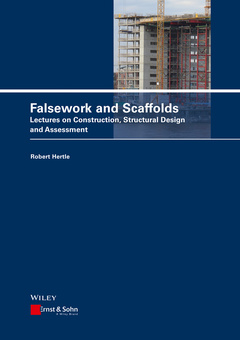Description
Scaffolds and Falsework
Constructions, Structural Design, Assessment
Author: Hertle Robert
Language: English
Subject for Scaffolds and Falsework:
250 p.
· 17x24 cm
· Hardback
Description
/li>Contents
/li>Biography
/li>
When designing and realizing commercial buildings, plants, bridges, tunnels and other types of engineering constructions as well as when defining constructions sequences in ship yards and process oriented measurements in other industrial branches, it is crucial to take concern of the essential boundary conditions resulting from the choice of temporary works equipment, e.g. falsework, formwork and both working and access scaffolds, and protection scaffolds.
In addition it is essential to comprehend temporary works equipment as an integral part of the building site technology. An appropriate analysis of the interaction between temporary works equipment and the future construction, considering structural aspects as well as work on site aspects, is essential for the overall success of a project.
The European harmonization and standardization process results in updating and modernizing the generally acknowledged set of technical regulations for temporary works equipment.
This book focuses on selected topics of temporary works equipment, especially on structural and safety aspects. It is based on twenty years of experience in planning and consultancy in structural engineering, e.g. bridges, industrial plants, temporary structures. The author brings in his background knowledge from the European and German standard committees.
In addition it is essential to comprehend temporary works equipment as an integral part of the building site technology. An appropriate analysis of the interaction between temporary works equipment and the future construction, considering structural aspects as well as work on site aspects, is essential for the overall success of a project.
The European harmonization and standardization process results in updating and modernizing the generally acknowledged set of technical regulations for temporary works equipment.
This book focuses on selected topics of temporary works equipment, especially on structural and safety aspects. It is based on twenty years of experience in planning and consultancy in structural engineering, e.g. bridges, industrial plants, temporary structures. The author brings in his background knowledge from the European and German standard committees.
Preface
Acknowledgements
1 Introduction
2 Design Environment
3 History
4 Materials
4.1 General Remarks
4.2 Metallic Materials
4.3 Wood and Wood-based Materials
4.4 Synthetics
4.5 Further Materials
5 Construction Elements
5.1 General Remarks
5.2 Design-related and Application-orientated Constraints
5.3 Production-orientated Constraints
5.4 Structural Design Particularities
5.5 Couplers
5.6 Girder Clamps
5.7 Modular Node Points
5.8 Joints by Overlap
5.9 Joints by Contact
5.10 Externally Stayed Node Points made of Stacked Elements
5.11 Anchoring
5.12 Other Connection Devices
6 Testing
6.1 General Remarks
6.2 Tests on Bracing Assemblies
6.3 Tests on Node Points
6.4 Measurements for Defining Imperfections
6.5 Evaluation Principles
7 Complementary Considerations
7.1 General Remarks
7.2 Structural Safety Concept
7.3 Imperfections in Temporary Works Equipment
7.4 Shear-Stiffness and P-?-Effects
7.5 Forces and Moments in Falsework-Bays
7.6 Stiffeners on H-Sections
7.7 Non-linear Effects
7.8 Falsework Manipulation
7.9 Falsework and Prestressed-Concrete
7.10 Falsework, Scaffolds and Geotechnics
8 Rules and Regulations
8.1 General Remarks
8.2 Comments on the European Standards and on Complementary Rules and Regulations
8.3 Temporary Works Equipment and Occupational Safety
9 Falsework Applications
9.1 General Remarks
9.2 Lessons from Failures
9.3 Vertical Load Bearing Components
9.4 Joists and Bracing Assemblies
9.5 Falsework Girders
9.6 Formwork Constructions
9.7 Climbing Falsework
9.8 Falsework for Commercial Constructions
9.8 Falsework for Bridges
9.9 Falsework for Tunnels
10 Scaffold Applications
10.1 General Remarks
10.2 Lessons from Failures
10.3 Frame Scaffolds
10.4 Modular Scaffolds
10.5 Tube and Fitting Scaffolds, Ladder Scaffolds
10.6 Protection Scaffolds
11 Construction Site Interaction
References
Acknowledgements
1 Introduction
2 Design Environment
3 History
4 Materials
4.1 General Remarks
4.2 Metallic Materials
4.3 Wood and Wood-based Materials
4.4 Synthetics
4.5 Further Materials
5 Construction Elements
5.1 General Remarks
5.2 Design-related and Application-orientated Constraints
5.3 Production-orientated Constraints
5.4 Structural Design Particularities
5.5 Couplers
5.6 Girder Clamps
5.7 Modular Node Points
5.8 Joints by Overlap
5.9 Joints by Contact
5.10 Externally Stayed Node Points made of Stacked Elements
5.11 Anchoring
5.12 Other Connection Devices
6 Testing
6.1 General Remarks
6.2 Tests on Bracing Assemblies
6.3 Tests on Node Points
6.4 Measurements for Defining Imperfections
6.5 Evaluation Principles
7 Complementary Considerations
7.1 General Remarks
7.2 Structural Safety Concept
7.3 Imperfections in Temporary Works Equipment
7.4 Shear-Stiffness and P-?-Effects
7.5 Forces and Moments in Falsework-Bays
7.6 Stiffeners on H-Sections
7.7 Non-linear Effects
7.8 Falsework Manipulation
7.9 Falsework and Prestressed-Concrete
7.10 Falsework, Scaffolds and Geotechnics
8 Rules and Regulations
8.1 General Remarks
8.2 Comments on the European Standards and on Complementary Rules and Regulations
8.3 Temporary Works Equipment and Occupational Safety
9 Falsework Applications
9.1 General Remarks
9.2 Lessons from Failures
9.3 Vertical Load Bearing Components
9.4 Joists and Bracing Assemblies
9.5 Falsework Girders
9.6 Formwork Constructions
9.7 Climbing Falsework
9.8 Falsework for Commercial Constructions
9.8 Falsework for Bridges
9.9 Falsework for Tunnels
10 Scaffold Applications
10.1 General Remarks
10.2 Lessons from Failures
10.3 Frame Scaffolds
10.4 Modular Scaffolds
10.5 Tube and Fitting Scaffolds, Ladder Scaffolds
10.6 Protection Scaffolds
11 Construction Site Interaction
References
Dr.-Ing. Robert Hertle studied structural and civil engineering at the Technical University Munich and gained his doctorate from this university. In 1992 he founded the Consulting Company Hertle Ingenieure.
Robert Hertle is a licensed checking engineer for structural design and a court appointed expert in the fields dynamics, steel construction, falsework and scaffolds. He is member and chairman of national and international working committees on technical standards, e.g. CEN/TC53 Temporary Works Equipment. At the TU Munich he is a Honorary Professor since 2012.
Robert Hertle is a licensed checking engineer for structural design and a court appointed expert in the fields dynamics, steel construction, falsework and scaffolds. He is member and chairman of national and international working committees on technical standards, e.g. CEN/TC53 Temporary Works Equipment. At the TU Munich he is a Honorary Professor since 2012.
© 2024 LAVOISIER S.A.S.
These books may interest you

Temporary Structure Design 118.16 €

Temporary structures in construction 106.83 €


